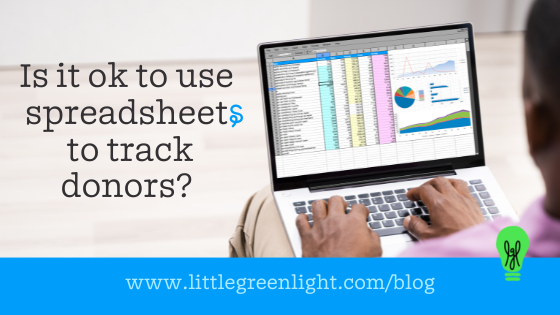Little Green Light is a cloud-based donor management system for fundraisers.
Subscribe to get our latest product updates, best practices and tips to grow your nonprofit.

As a new nonprofit organization you may be wondering, “Is it ok to use spreadsheets to track donors?”
If you’re working on capacity building for a brand-new nonprofit, you will likely be tempted to track your list of potential donors in an Excel spreadsheet or Google Sheet. But is it a mistake to do this? This exact question came up recently in one of our Little Green Light Prospective Customer Q&A sessions.
It might surprise you to learn that my answer was, “No, it’s not necessarily a mistake.”
This may sound odd coming from someone who works in Sales for Little Green Light (which is a terrific low-cost donor management system for nonprofits). But the reality is that if your organization is just starting out, you might not have the resources (human or financial) for a full-fledged donor management system. Especially while your potential donor list is still small—under 200 people, let’s say—a spreadsheet can be a great place to start.
And, in fact, over 40 percent of Little Green Light customers were using spreadsheets to manage their donors prior to LGL. So, we know it is a common solution for many nonprofits.
It is, however, important to ensure that your spreadsheet data is well organized. This will also be extremely helpful if and when you do move to a donor management CRM database, because it will make importing your data much easier.
Pro tip: In LGL we use a field called Employer/Organization, and it is the same field that can be used for the employer name in Individual constituent records and the organization name in Organization constituent records.
Pro tip: If the email address is in each of your spreadsheets, then you can use the incredibly useful vlookup function that’s part of Excel and Google Sheets to pull information from one spreadsheet into another spreadsheet. See a Google search on how vlookup works.
Important note: Be sure you use separate columns for the gift date and gift amount, and make certain only a full date (e.g., 1/20/2022) is used for the gift date and just the number (e.g., 250) is used for the amount. Avoid the temptation of adding text notes to either piece of data, and avoid combining those two pieces of data into one column.
Pro tip: Pivot tables are an essential feature in both Excel and Google Sheets, and they allow you to sum gift data by donor.
This worksheet provides several spreadsheet templates that you can use to track donors and gifts. There is also a sheet included that explains the steps for importing these spreadsheets into Little Green Light, which is the donor management system we recommend you move to when you outgrow spreadsheets.
Free downloads of this spreadsheet template are available as a Google Sheet or Excel file.
Spreadsheets are an effective place to start, but since they will not serve you forever I’d like to share some indications for when it is time to move to a true donor management system.
Comments are closed.
Comments are closed.
Ready to try LGL? Get your first 30 days free. No credit card required.
Looking beyond the start-up period and spreadsheet: I would suggest creating a unique ID for each constituent and using it for each of that constituent’s materials in every spreadsheet. Such an ID will facilitate sorting and retrieving segmented data within the spreadsheets. More importantly, when the organization is ready for a relational database, importing each spreadsheet into the database and using the unique ID to enforce referential integrity will be a simple, straightforward process. Incidentally, I can use Excel but am primarily an Access junkie who used this process to move a large amount of data from a failing CRM product to a fairly sophisticated database via .csv. My organization is now looking at LGL as a likely successor, owing to its online access to multiple users and the availability of some standard CRM reports.
R.C.,
That’s an excellent point about creating a unique ID! And, we’re thrilled to hear you are considering LGL as your organization’s first donor management system!
Thanks,
Timi
Very helpful. Thanks!